Posted by Anita on 04.07.08 4:22 PM
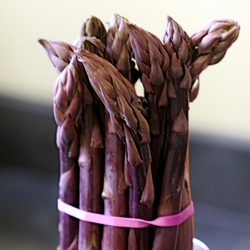 I think it’s safe to say that by any objective measure, Dark Days are well behind us here in San Francisco. Asparagus has been on the farm tables for a month, strawberries made their Ferry Plaza debut this Saturday, and — hooray! — the first pasture-raised chicken of 2008 made its way into our bag (and our bellies) yesterday.
I think it’s safe to say that by any objective measure, Dark Days are well behind us here in San Francisco. Asparagus has been on the farm tables for a month, strawberries made their Ferry Plaza debut this Saturday, and — hooray! — the first pasture-raised chicken of 2008 made its way into our bag (and our bellies) yesterday.
Spring has indeed sprung. And with the dawning of a new season comes the end of the Dark Days Eat Local Challenge.
I know you probably won’t be shocked to hear that April 1 didn’t look a whole lot different in our kitchen than March 31. We’re not going to stop hunting down locally produced foods just because we aren’t documenting every last morsel, after all. Three of the last five dinners we’ve eaten have been made with 100% local ingredients, so I think we’re safely launched down this particular path.
 And for that, I owe huge debt to Laura — for dreaming up Dark Days, for hosting the weekly roundups last fall, and for extending the challenge into 2008 when we all clamored for more. I can only imagine how she manages her own blog and handles her roundups of every Dark Days blogger in the country, all while moving onto her new farm, raising a new brood of chicks, and working a full-time job. (Honestly, I’m exhausted just thinking about it…) I know in my heart that we’d never have dug as deep into our food chain if it hadn’t been for the thrill of the challenge, and knowing we had a built-in audience of Dark Days participants who would share our excitement.
And for that, I owe huge debt to Laura — for dreaming up Dark Days, for hosting the weekly roundups last fall, and for extending the challenge into 2008 when we all clamored for more. I can only imagine how she manages her own blog and handles her roundups of every Dark Days blogger in the country, all while moving onto her new farm, raising a new brood of chicks, and working a full-time job. (Honestly, I’m exhausted just thinking about it…) I know in my heart that we’d never have dug as deep into our food chain if it hadn’t been for the thrill of the challenge, and knowing we had a built-in audience of Dark Days participants who would share our excitement.
Although we’ll stop with our periodic Dark Days wrap-ups, you haven’t heard the last of our locavore ways. In fact, I had high hopes of debuting a new “Bay Area Pantry” page this weekend, showcasing all the products we’ve found that are grown or produced within our foodshed radius. The good news is that it’s 90% ready; the bad news is that time ran out on me, and the final Dark Days roundup must go on, with or without me. I still need to add some links, photos, and section headings, but I’ll let you know when the pantry is fit for public consumption.
In the meantime: Here’s to spring — Let the asparagus-gorging begin!
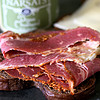



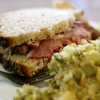
Dark Days Ticker — March 16-31
– Dark Days dinners at home: 9 out of 16
– Locavore dining-out: MÅno, O Izakaya, Marin Sun Farms butcher shop / tour lunch
– New recipes: Reuben sandwiches, feta-stuffed lamb burgers, English muffin bread
– Old faves: Not-Spam and Eggs, choucroute garnie, gumbo, beef stew, Thai beef salad
– Freezer fodder: A16 meatballs, beef stew, Mamster’s carnitas, pasta bolognese
New local items in the pantry:
Middle Eastern Baking lavash (Millbrae)
Hamati pita (San Bruno)
Sconehenge English muffins (Berkeley)
Achadinha brined goat feta (Petaluma)
Fatted Calf sauerkraut, andouille, bockwurst, pastrami (Napa)
Marin Sun Farms slab bacon (Point Reyes)
Alexander Valley Gourmet sauerkraut
cooking, Dark Days challenge, locavore, other blogs
6 Comments »




Posted by Anita on 04.06.08 12:03 PM
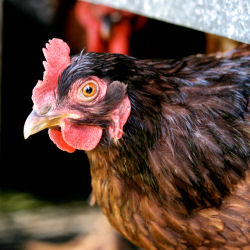 Before Niman Ranch started raising their herds on Iowa feedlots, their marketing materials bragged about “happy cows with ocean views”. Last Sunday, as we popped over the crest of Pierce Point Road and saw limitless green pasture dotted with black steers overlooking the deep blue waters of the Pacific, I gasped: It was exactly the scene that I’d held in my mind’s eye all these years. Only this land and these cattle belong to Marin Sun Farms, the ranch that supplies us with most of our eggs and meat.
Before Niman Ranch started raising their herds on Iowa feedlots, their marketing materials bragged about “happy cows with ocean views”. Last Sunday, as we popped over the crest of Pierce Point Road and saw limitless green pasture dotted with black steers overlooking the deep blue waters of the Pacific, I gasped: It was exactly the scene that I’d held in my mind’s eye all these years. Only this land and these cattle belong to Marin Sun Farms, the ranch that supplies us with most of our eggs and meat.
Even a week after our visit, I’m having a hard time expressing the depth of my awe for what David Evans is doing out on his Historic H Ranch, just 50 miles north of San Francisco. David’s family has farmed this same land since the early 1900s, although they were forced to sell it in the 1970s under the eminent domain act that created the Point Reyes National Seashore. The family leases back the land under what seems to be very tenuous circumstances: 5 year terms and government oversight of terribly minute details like the size of chicken flocks. Needless to say, it’s not the sort of sustainable permanence that makes this consumer particularly content.
Pronounced David’s way, the enterprise responsible for much of our weekly protein is properly known as “Marin Sun Farms” not “Marin Sun Farms.” Like his mentor Joel Salatin — who famously explained to Michael Pollan that he was a “grass farmer” — David takes pains to emphasize that his husbandry converts solar energy, by way of living pasture, into proteins that humans can digest. It’s half clever and half hokey, but undeniably true.
We started our tour overlooking the pasture where cows and calves ambled up and down spring-green hills, lolling in the lush grass or drinking from a large, clear pond. David talked at length about his ideology and his farming methods, explaining how herds — both chickens and cows — are moved to a different patch of land each week, preserving the pasture from over-grazing and enhancing the soil with their manure.
We peeked into a converted freight trailer turned chicken nursery, spying four gaggles of Easter-perfect chicks peeping around under heat lamps, pecking away at their feed. From there, we strolled down a wide lane to look in on David’s sister’s goat herd, busily clearing a scrubby yard where vegetables had been grown over the previous winter.
Beyond the goat yard, we saw two quonset hut-shaped structures on a distant hillside, our first glimpse of the farm’s egg-laying operation. Built of canvas-like material stretched over simple wood frames, these chicken houses open directly onto open pasture, without any physical barriers to any one of the chickens flying or wandering off. Apparently their social structure makes that unlikely; they’re much more apt to leave in the clutches of a predator, according to David. Perhaps half of the chickens roosted inside their homes, and the remainder scratched and pecked and flapped away outside in the open air. Glancing at the wide range of breeds, I suddenly understood the diversity of the colors and sizes of the eggs in our weekly dozen.
Many of us remarked with surprise that this egg-laying flock included a fairly large number of roosters, in addition to the laying hens. “I don’t do it so we can say the eggs are fertile,” said David, “But I know that I wouldn’t be happy in an environment without females, and I don’t think any of you ladies would be happy in a world without men.” Even as an unrepentant omnivore, it’s hard to wrap your brain around someone who makes his living selling meat treating his product with such humane regard.
Up the road a piece, we called on the broiler flocks, grown-up versions of the fuzzy peeps we’d seen pecking in the nursery. Penned in movable, mesh-covered yards — half in sun, half in shade — these birds were, quite frankly, the ugly ducklings of the farm. Where the laying hens are diverse and beautiful, Cornish Cross broilers look like the freaks of nature we’ve bred them to be. Sparsely feathered, dull around the eyes, and unbelievably gawky, these aren’t birds you feel too much sentiment toward. Still, they’re cared for with the same meticulous attention. They’re fed organic cracked grain, supplementing all the insects and grubs they can forage from their patch of pasture. At the end of the week, when they’ve cleared the pests and fertilized the land beneath their enclosures, their coops are canted up on a large dolly and rolled forward to a new stretch of green grass.
Sounds bucolic, and it certainly looks that way, too. Are things 100% perfect on this pastoral land? I’m sure they’re not. I would have been happier not knowing that Marin Sun Farms broiler chicks are fed imported Chinese soy until they’re old enough to digest corn and grubs. Or that David feels that heirloom birds are just too expensive (twice the cost of the already pricey hybrids he brings to market, he says) and don’t taste any better than the ugly mutants. Or that most of the calves born at his parents’ H Ranch operation are destined for life on the feedlots of the Midwest, because there simply isn’t enough demand for pasture-raised beef. But despite all of the things that I wish they were doing more-perfectly, the simple fact is that I am in awe of the 99% that Marin Sun Farms is doing exactly right.
Rounding our way back to the main barn, David stopped to talk about the on-farm ‘processing’ — that is, slaughtering — that farmers are, thankfully, still allowed to do for their own poultry. As he explained that the next part of the tour was occasionally more than some visitors had bargained for, I finally focused beyond David’s shoulder, at last noticing a critical part of the farm that had previously escaped my notice. Having read Michael Pollan’s description of the Polyface Farms “abattoir without walls,” I knew enough to recognize it: The metal cones where chickens are killed and bled out, the plucking machine with its hundred rubber ‘fingers’, the well-worn worktables, the buckets for the blood and guts that get turned into the compost pile to amend the land. No roof, no walls; everything open to the sun and the wind, nature’s original sanitizers. It was all right there… right there for anyone to see, to understand.
I knew well enough we wouldn’t see any chickens slaughtered that Sunday — it happens on Thursdays, anyway, and the oldest of this season’s broilers were still a week from market, merrily clucking away in the pasture. Nothing had been slaughtered here since the old roosters and hens had come to market last winter; the killing place smelled of nothing but the hillside around us. And yet, it had the undeniable air of purpose. I won’t insult you by saying it felt holy, but I do know that there was no nervous laughter, no chatter, no wandering off to investigate something more interesting around the corner. Every one of us on that tour, kids included, was completely present there, standing inside the boundaries of the place where animals became food: The place where each bird experiences what David calls its “one bad day” on the farm.
—-
When the tour was over, we caravaned back over the road to Route 1. David treated everyone to lunch at the Marin Sun Farms Butcher Shop, a bountiful spread of Della Fattoria bread, the farm’s own rib eye and roast goat, bowlsful of aioli and horseradish cream and salsa verde, and buckets of German-style potato salad with flecked with rich bacon.
But the best part of the lunch was the beverage: David brought out “a gift” — which he couldn’t legally sell to us — of a few gallons of raw milk “just hours out of the cow” in oversized Mason jars. I’d shied away from buying raw milk at the stores, imagining that it would taste grassy or gamey. But oh, lord, what I’d been missing! It just tasted more milk-y, like a better version of the best milk you’ve ever had. Nuances of flavor, texture, and color are apparent even to the most casual observer.
Needless to say, we bought a quart of Claravale raw milk this Saturday, and I don’t expect to go back to the sterile, flat stuff anytime soon. Nor do I expect I will soon forget the windy spring morning when I looked my supper in the eye and made peace with my place on this sustainable food chain.

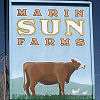
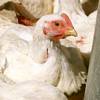
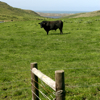
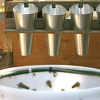
Marin Sun Farms
10905 Shoreline Highway
Point Reyes Station, CA 94956
415-663-8997
Meat CSA memberships available starting at $270 for a 6-month session
Retail sales available at the Point Reyes butcher shop, Saturday Ferry Plaza Farmers Market and Sunday San Rafael Civic Center Farmers Market
Next farm tour: May 18, 2008
Adults $30, Kids $10
(Pre-registration is mandatory)
Dark Days challenge, farmers markets, farms & farmers, locavore, meat, shopping
13 Comments »




Posted by Anita on 03.27.08 7:57 PM
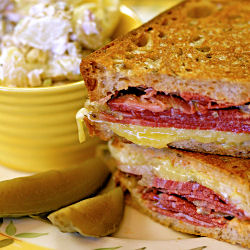 There’s a strange thing that happens in Seattle. (OK, there are many strange things that happen there, but this one is food related.) Some restaurant — usually a reasonably popular one — puts a relatively obscure but approachable item on the menu, and before you can say “hamburger with a fried egg on top”, said item pops up on menus everywhere, from divey diners to haute-cuisine haunts.
There’s a strange thing that happens in Seattle. (OK, there are many strange things that happen there, but this one is food related.) Some restaurant — usually a reasonably popular one — puts a relatively obscure but approachable item on the menu, and before you can say “hamburger with a fried egg on top”, said item pops up on menus everywhere, from divey diners to haute-cuisine haunts.
Thus it is with the Reuben, the sandwich some might call Seattle’s signature. And it’s no great mystery why: There’s something irresistibly naughty — not to mention entirely un-Kosher — about a deli sandwich that combines salty corned beef, gooey cheese, zippy Russian dressing, and crunchy sauerkraut between two slices of butter-grilled rye bread. A Reuben is the perfect antidote for drizzly, chilly Northwest weather, an overstuffed slice of golden sunshine on a plate. Served with a garlicky dill pickle and a ramekin of good potato salad, there’s hardly any better cure for grey-day blues.
Child of the sunny Southland that I am, it’s entirely possible that I had never eaten a Reuben before we moved to Jet City. I quickly made up for lost time: Fremont’s Red Door tavern used to make a pretty good example, as did our old ‘local’ pub, the 74th Street Ale House on Phinney Ridge. Once we moved across town to Madison Valley, it was only a matter of days before I discovered the heavenly Reuben — and his turkey-licious sibling, Rachel — served on just-baked sour rye at the Essential Bakery Cafe. I could probably fill an entire post with Seattle Reubens I Have Known and Loved. (Thankfully, I managed to avoid the vegan one!)
Once we moved back home to San Francisco, I don’t think I ever encountered a Reuben on a restaurant menu. I’m sure Reubens exist somewhere within our seven-by-seven grid, but so far we have yet to cross one another’s paths. It’s a sad truth that moving from city to city often means leaving behind foods (and friends) you’ve grown to love.
Luckily, once you have the right ingredients, it’s easy to make your own fabulous Reuben. Sure, you can pick up pretty good deli meats around town, but one of the the best reasons to make your own corned beef is that you’ll have plenty of leftovers. Leave the little trimmings and end bits for tomorrow morning’s hash; the best and highest use of that glistening chunk of pink, lipid-laced meat lies between two slices of good bread. Shave it thin with your sharpest blade, and don’t stop until you’ve got a goodly pile.
—-
Knowing there were Reubens in our future, we picked up a loaf New York Rye from Acme and a hunk of Spring Hill’s Portuguese cheese, which makes a better-than-decent stand-in for Swiss. We thought we would be out of luck finding local sauerkraut, until fate intervened. The good news: Not one but two of our favorite local purveyors has just recently started brining their own ‘kraut. Fatted Calf sells a chunky, tangy variety, and Alexander Valley Gourmet sells a crisper, finer-gauge flavor. Happily, both are excellent, and equally well suited to Reuben-making.
The bad news: Neither brand is (yet) available in San Francisco. Fatted Calf sells theirs over the counter at their Oxbow shop but, alas, not at their market stands. Alexander Valley is wrestling with the classic shelf-space squeeze: So far, no San Francisco shop has made room for their newest product. (There’s hope, though: Alexander Valley’s fresh pickles are already available at Whole Foods, Rainbow Grocery, and Andronico’s; if you want the ‘kraut, too, leave a note for the manager asking that they stock it. So far, the new Napa branch of Whole Foods is as close as we’ve been able to locate it.)
With two containers of locally made sauerkraut in the fridge, all that remained was the Russian dressing. We stirred together some homemade mayo, a bit of last summer’s tomato jam, a blob of local horseradish, a few chopped pickles… and got ready to griddle. Sure, Thousand Island dressing would have done in a pinch, but we decided that making a 100%-local sandwich was worth a few minutes of extra prep.
And let me tell you: It was a Reuben to make you forget all the others.
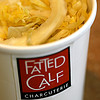
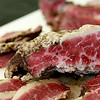


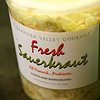
The Perfect Reuben Sandwich
Here’s the part where I would normally explain exactly how to craft the platonic ideal of a Reuben sandwich. But frankly, there’s no way I could possibly improve on the recipe we found on Epicurious, as transcribed from Arthur Schwartz’s New York City Food.
If you think the Zuni Cafe mock porchetta recipe is detailed, let me assure you: It ain’t got nothin’ on Schwartz’s step-by-step tutorial on building the proper Reuben sandwich. The devil may be in the details, but the details are in Schwartz’s Reuben.
Dark Days challenge, locavore, lunch, Seattle
14 Comments »




Posted by Anita on 03.20.08 11:44 PM
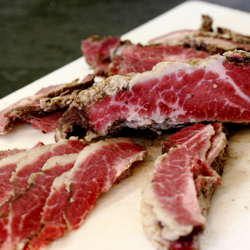 If you ask Cameron what his favorite cold-weather meal is, you might be in for a surprise. It’s not Thanksgiving turkey with all the trimmings. It’s not even a big prime rib, with plenty of leftovers for his beloved beef-and-bleu sandwiches. No, the thing my Scots-Irish husband loves best when the nights are long is New England Boiled Dinner — better known as “corned beef and cabbage” — with a hearty dollop of horseradish cream and an imperial pint of stout to wash it down.
If you ask Cameron what his favorite cold-weather meal is, you might be in for a surprise. It’s not Thanksgiving turkey with all the trimmings. It’s not even a big prime rib, with plenty of leftovers for his beloved beef-and-bleu sandwiches. No, the thing my Scots-Irish husband loves best when the nights are long is New England Boiled Dinner — better known as “corned beef and cabbage” — with a hearty dollop of horseradish cream and an imperial pint of stout to wash it down.
Like most folks, we’ve reserved this marvelously meaty meal for St. Patrick’s Day feasts. But given how cheap it is, and how much we enjoy it, I’m not entirely sure why we don’t trot it out regularly. Perhaps we got in the habit back when it was difficult to find corned beef during the rest of the year. But the last few winters, we’ve taken to curing our own brisket, so getting our hands on nice corned beef isn’t so much of a problem.
I know there are at least two of you who know our little secret: Home-cured corned beef only sounds impressively arcane; it’s actually about the easiest thing you can cure at home. The only thing you need is a 4-to-6 pound piece of brisket — point cut, preferrably — plus a few easy-to-find spices and a week’s forethought. And if you use a dry cure like the Cooks’ Illustrated recipe [link removed*] we often follow, rather than the typical immersion brine, you don’t even need a lot of fridge space. Honestly, we’ve got to do this more often… if only for the crave-inducing leftovers.
 This year’s brisket came to us from Marin Sun Farms, and a glorious specimen it was. For the accompaniments, we wandered the Ferry Plaza market and rounded up a Catalan Farms cabbage, two pounds of Little’s potatoes, a bunch of Star Route Farms carrots, a pile of Dirty Girl boiling onions, and a couple of rutabagas from Heirloom Organic. Imagine our surprise as we walked by the Happy Girl Kitchen pickle stand on our way back to the car and noticed they were selling prepared horseradish! (Yes, it was local — grown at Tairwa Knoll Farms and processed in Santa Cruz County — and delicious.) On the way home, we popped by our local microbrewery, 21st Amendment, and picked up a growler of their oyster stout. Ah, it was the easiest 100% local meal of the month, to be sure, and definitely one of the tastiest.
This year’s brisket came to us from Marin Sun Farms, and a glorious specimen it was. For the accompaniments, we wandered the Ferry Plaza market and rounded up a Catalan Farms cabbage, two pounds of Little’s potatoes, a bunch of Star Route Farms carrots, a pile of Dirty Girl boiling onions, and a couple of rutabagas from Heirloom Organic. Imagine our surprise as we walked by the Happy Girl Kitchen pickle stand on our way back to the car and noticed they were selling prepared horseradish! (Yes, it was local — grown at Tairwa Knoll Farms and processed in Santa Cruz County — and delicious.) On the way home, we popped by our local microbrewery, 21st Amendment, and picked up a growler of their oyster stout. Ah, it was the easiest 100% local meal of the month, to be sure, and definitely one of the tastiest.
The rest of the fortnight was full of other tasty tidbits, including six meals at restaurants that wear their locavore menus on their sleeves. You’ll recognize lots of old standbys in the list below, and a pair of newcomers. Let’s just say that Conduit seems to be still working the kinks out of their kitchen; they’ve only just opened, so we’ll keep mum. On the other hand, Ubuntu is old enough to know better. I wish we had loved every bite at this nationally fawned-upon Napa newcomer, but — as our friend and dining companion Cookiecrumb detailed elsewhere — the inventive flavors and gorgeous ingredients were so oversalted as to be nearly inedible. Ah, well… they can’t all be Range, I suppose.
Mercifully, we did not return home hungry. There were plenty of other delicious things we discovered on our Napa field trip, including a to-die-for packet of pastrami (from Fatted Calf’s gorgeous new shop at the Oxbow Market) that had us happily gorging on sandwiches… even for breakfast. And we also discovered another secret ingredient that we’ll share more about in our next Dark Days installment.



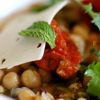
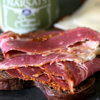
Dark Days Ticker — March 1-15
– Dark Days dinners at home: 8 out of 15
– Locavore dining-out: Range, Primavera, ubuntu, O Izakaya, Two, Conduit
– New recipes: Jamie’s stuffed potatoes, Hugh’s milk-braised pork, cauliflower steaks
– Old faves: corned beef & cabbage, egg drop soup, bean salad, Waltuck‘s chicken paprikás, grilled rib-eye
– Freezer fodder: golden veggie bisque, potstickers, chili verde enchiladas, oxtail ragu, bolognese sauce
New local items in the pantry:
– Straus Creamery cream-top milk (2% and whole)
– Marin Sun Farms point-cut brisket
– Fatted Calf pastrami (available at their Napa store only, alas!) and bierwurst
– Little‘s “all blue” potatoes
– Zuckerman’s asparagus
– Happy Girl Kitchen Co. prepared horseradish
– Andante butter
– 21st Amendment Oyster Stout (brewed with Hog Island oysters!)
– Carmel S&S Syrah (thanks, Lauren!)
– Bartholomew Park Cabernet
—-
* Edited to add: We removed the link to the Cook’s Illustrated recipe in July 2008 in protest of their bullying tactics.
beer, Dark Days challenge, holidays & occasions, locavore, meat, Napa & Sonoma, restaurants
12 Comments »




Posted by Anita on 03.09.08 3:48 PM
 Our main fridge in the kitchen is a counter-depth, side-by-side model. Its narrow, shallow freezer doesn’t hold a lot, volume-wise, but picking a bigger fridge would have meant a lot of kitchen remodel trade-offs that we weren’t willing to make. The ancient fridge we inherited from the previous owners was wheezing and leaking by the time we started our remodel, so we killed two birds with one stone by buying an old-school (but brand-new and EnergyStar compliant) over/under fridge for the basement.
Our main fridge in the kitchen is a counter-depth, side-by-side model. Its narrow, shallow freezer doesn’t hold a lot, volume-wise, but picking a bigger fridge would have meant a lot of kitchen remodel trade-offs that we weren’t willing to make. The ancient fridge we inherited from the previous owners was wheezing and leaking by the time we started our remodel, so we killed two birds with one stone by buying an old-school (but brand-new and EnergyStar compliant) over/under fridge for the basement.
The plain-Jane newbie was a perfect stopgap for us to use until we moved back upstairs, and now we fill the basement fridge with all those goofy condiments we only need twice a year (cooking Thai food will do that to you) and extra beer. When fiesta time rolls around, the beer gets moved up to a cooler on the back porch, and the downstairs fridge gets filled with all the party mise en place. And, of course, the second fridge’s freezer is our storage vault for things like summer veggies, pasta sauce, make-ahead meals, and other frozen staples. We keep one or two packets of each thing in the main fridge, and the back-stock downstairs — a bit of it’s an oddball system, but it works for us.
At least 90% of the time it does. But when you’re prone to making megabatches of chicken stock, things can go south pretty quickly.
Last week, I innocently opened the freezer door in search of some chile verde, and a tectonic shift sent plastic-encased projectiles plummeting toward the floor. Thank goodness I had my clogs on, or I might’ve lost a toe! I’d stacked food cubes like a giant game of Tetris — or maybe more like Jenga — and I’d paid the price. Clearly, my version of Fibber McGee’s closet needed a clean sweep. I took everything out of the freezer (note to self: wear gloves next time!) and reconfigured it all in a less-precarious arrangement. Still, though, the tiny compartment was pretty close to capacity.
To try and eat down our storage problem, I put us on a strict diet: Every dinner we ate at home had to have at least one frozen element… at least until there was enough room to store another batch of Bolognese sauce. (It’s nice to have problems that can be solved by eating.) With spring on the horizon, it seemed safe to start really digging into our local-food stash. After all, we’ll start seeing roaster/fryer chickens at the market again next month, and we’ve got plenty of canned tomatoes to last us through to the new season — the hothouse Early Girls are already coming in, much to my shock.
Due to a combination of Presidents’ Day weekend festivities and long nights at the office, we only managed 5 dinners at home during the last half of February — all of them, of course, at least partially from the freezer. We’ll keep plugging away at our hoard over the next few weeks, but now there’s enough breathing room in the freezer that I don’t feel bad eating the occasional freshly prepared supper.
In fact, the downstairs freezer is looking downright breezy at the moment… A phenomenon that should last until we start getting 9 pounds a month of sustainable, local beef, pork, and lamb from Marin Sun Farms’ new meat CSA.
Hmm, do you think a third fridge would be excessive?





Dark Days Ticker — February 15 to 29
– Dark Days dinners at home: 5 dinners
– Locavore dining-out: O Izakaya Lounge, Primavera, Tacubaya
– Freezer fodder: Short-rib ragu, Cornish pasties, rigatoni bolognese, turkey meatballs, chicken pot-pie
New local items in the pantry:
– Scharffen Berger cocoa powder (Berkeley, 13 miles)
– Marin Sun Farms pastured eggs (Point Reyes Station , 44 miles)
– Katz champagne vinegar (Napa, 57 miles)
Dark Days challenge, locavore, preserving & infusing
16 Comments »




Posted by Anita on 02.24.08 2:21 PM
 We’ve talked a lot about our Dark Days Challenge dinners, and even occasionally mention our lunchtime trials, but — aside from our “free-range” egg dilemma — we’ve rarely made a peep about breakfast. The truth of the matter is we’re in a bit of a rut: Nearly every morning, Cameron eats an over-easy egg and a slice of Acme toast with Spring Hill farmstead butter. Not such a fan of the usual breakfast fare, morning often finds me dipping into leftovers, cannibalizing my lunch, or scrounging some other non-breakfasty breakfast.
We’ve talked a lot about our Dark Days Challenge dinners, and even occasionally mention our lunchtime trials, but — aside from our “free-range” egg dilemma — we’ve rarely made a peep about breakfast. The truth of the matter is we’re in a bit of a rut: Nearly every morning, Cameron eats an over-easy egg and a slice of Acme toast with Spring Hill farmstead butter. Not such a fan of the usual breakfast fare, morning often finds me dipping into leftovers, cannibalizing my lunch, or scrounging some other non-breakfasty breakfast.
But when the weekends roll around, it’s big-breakfast time for both of us. Every Saturday, we head to the Primavera stand at the Ferry Plaza Farmers’ Market at the start of our shopping rounds. We’re so predictable that David and Paulette know us by name, tease us when we’re bleary-eyed, and generally treat us like the regulars we are. Some days we split a single order of chilaquiles, but more often — especially if there’s something else on the changing menu that catches our eye, like fish tacos, perhaps, or tacos al pastor — we’ll each get our own plate and share. Primavera’s tortillas and chips aren’t made from local corn, but they do manufacture both items in Napa, and purchase their eggs and produce from local farms. Judged by volume, our Saturday breakfasts probably don’t quite make it to the 90%-local mark, but we’re content with understanding exactly where our food is coming from, and knowing that we’re directly supporting such a fabulous crew.
We often stay up late on Saturday nights, so Sunday breakfast is more of a brunch-time affair. Sometimes we’ll brown some homemade pork sausage and Cameron will whip up biscuits and gravy with scrambled eggs. Other times we’ll simply fry up some local bacon — we alternate between Fatted Calf and Range Brothers — and serve it alongside two of Cameron’s perfect basted eggs and a slice of Acme toast topped with June Taylor preserves or local honey. We rarely plan these Sunday meals in advance, and yet they’re always wonderful.
During the first part of the month, we had two of my favorite brunches of all time: a post-porchetta batch of hash with poached eggs and buttery toast, and a plate of custardy French toast made from leftover baguette slices (we froze two bags full after the cocktail party!) alongside Range Brothers sausage. With the exception of maple syrup, and the flour in the locally made bread, everything on our table on both mornings was 100% local. And 100% fabulous.
For the most part, we stuck with old favorites and tried-and-true options for lunches and dinners in the first part of the month; even our Valentine’s Day dinner was a simple grilled steak with creamed spinach and roasted potatoes, with ice-cream sundaes for dessert. We did have one out-of-the-ordinary supper: A picnic in a cozy downtown hotel room. Much as I’d love to tell you that we planned a romantic escape, the truth is that the overgrown frat-boy who lives in the house next door decided to have (yet another) all-night party, and we had to evacuate.
While Cameron packed up the dogs and our overnight bag, I headed to a local supermarket for makeshift meal provisions. The locavore-friendly pickings at the Bristol Farms around the corner from my office are pretty slim, but I did manage to score a crusty loaf of Artisan bread, some respectable sopressatta from a outfit called Ticino (a second-label brand from local mega-brand Columbus, it turns out), and a couple of nice local cheeses. A quick stop at CocoaBella turned up just two locally made treats: peanut butterflies and salt caramels from Charles Chocolates — a sweet ending to an otherwise hectic evening.


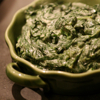
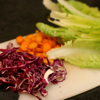

Dark Days Ticker — February 1 to 14
– Dark Days meals at home: 8 dinners, 2 brunches, most breakfasts
– Locavore dining-out: Range
– New recipes: Chard gratin, Coq au vin
– Old faves: porchetta, pork hash, shaved fennel salad, Clearman’s red cabbage slaw
– Freezer fodder: Rigatoni Bolognese, Cameron’s chicken soup
New local items in the pantry:
– Capellino spinach-ricotta ravioli (San Francisco — 5 miles)
– Charles Chocolates (Emeryville — 13 miles)
– Ticino sopressata (Hayward — 35 miles)
– Marin Sun Farms range roosters & stewing hens (Point Reyes Station — 43 miles)
– Artisan Bakers sweet batard (Sonoma — 47 miles)
– Barbara’s Natural potato chips (Petaluma — 51 miles)
– Rancho Gordo chiles de arbol (Napa — 51 miles)
– Marin Roots Farm mâche/lambs lettuce (Petaluma — 52 miles)
– Fiscalini Farmstead ‘San Joaquin Gold’ grating cheese (Modesto — 87 miles)
breakfast, Dark Days challenge, locavore, shopping
8 Comments »




Posted by Anita on 02.14.08 12:03 AM
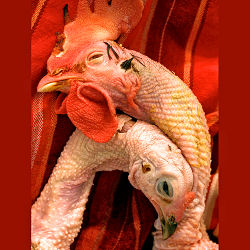 Have I mentioned lately how much I love the farmers who keep us fed? Even when I’ve done something utterly short-sighted, they managed to swoop in and save me from my own culinary stupidity.
Have I mentioned lately how much I love the farmers who keep us fed? Even when I’ve done something utterly short-sighted, they managed to swoop in and save me from my own culinary stupidity.
Last week, Cameron came up from the basement and announced that somehow we’d run out of chicken stock. “That’s impossible,” I replied. “We had gallons…” A quick trip down the stairs showed that he was right. GULP!
Given that our source of pastured, local chickens dried up before Thanksgiving and that I didn’t really do anything to prepare for this eventuality other than making my usual batches when the bone-bag filled up, I guess I am lucky to have made it this far into winter without running dry. But how could we survive months without a local source of one of our most necessary staples?
After three grocery stops, I finally managed to find local, organic chicken backs. Unfortunately, the Rosie chicken parts that Whole Foods carries come from factory organic farms — they’re local, technically, and ‘free range’, technically, but they’re not really my idea of humane, ethical meat. Unless I wanted to go without stock until spring, I was going to have to choose the lesser of various evils. I went home chickenless and annoyed at my lack of planning.
Two days later, whatever deity watches over locavores and other fools swooped in to save my bacon:
From: Cara, Marin Sun Farms
Subj: Range Hens & Roosters
Range hens and range roosters will be offered this weekend at our Farmer’s Markets and Butcher Shop in Point Reyes Station on a first come first serve basis.
I could hardly believe my eyes: pastured chickens, in February? We’ll take two, please. They weren’t cheap — one rooster and one hen tapped out our protein budget for the week (and then some). But they were there, and that’s all that mattered to me and the other folks who swarmed the stand as the market opened.
It turns out that these sturdy birds were no spring chickens [groan!]. Happy by-products of Marin Sun Farms’ egg production, they’re easily double the size of the birds we buy in the spring and summer.
If you think you’re smugly immune to the grim realities of chicken butchery after a summer of dainty heads and tiny feet, you’ve got another thing coming when your supper greets you with an open-eyed stare. And cutting big birds into parts is no trauma-free event, either. Like most other creatures, chickens’ bones and tendons firm up as they mature. The simple shears-and-boning-knife operation required to part out a 3-month-old fryer is a walk in the park compared with the hatchet-job required to take apart a full-grown rooster — and I have the torn-up hands to prove it.
Even if these birds hadn’t been freakishly large, their long, narrow breasts would be a dead giveaway. Barely more than one serving of white meat per bird, these bony chests make an almost-comical sight paired with long, rangy legs. “They look like chickens that tried out for the basketball team,” quipped Cameron.
Mature fowl are best cooked low and slow; one of the MSF farmers was telling folks at the stand that he’d made an exploratory batch of fried chicken, just to see, and… well, no surprise, he didn’t recommend anything but the soup pot or a long, slow stew for any of these tough old birds. (See how many American idioms come from our agricultural roots?)
Of course, any grandma will tell you that modern factory chicken doesn’t taste like it did in the olden days, and much of that has to do with the fact that today’s chickens are slaughtered well before they’re adolescent, much less geriatric. As early as the 1960s, full-fledged stewing chickens were hard enough to come by that even Julia was calling for a measly 2-1/2 to 3-pound fryer for her coq au vin.
Thankfully, we found a lovingly thorough recipe — avec un vrai coq — in our new copy of the River Cottage Meat Book, Hugh Fearnley-Whittingstall‘s ode to sustainable eating in all its carnivorous glory. “They might be scrawny and … on the tough side” says our man Hugh, “But with a diet comprising largely natural forage, by god they’d be tasty.”
Not that I’d ever gainsay a meat maven like Mister F-W, but old-man rooster was definitely an acquired taste, even if you’re used to the “more-chickeny” flavors of pastured meat. Don’t get me wrong: The flavor it lent to the sauce was truly unparallelled — an unctuous, meaty taste that felt in all ways more like beef stew than anything poultry based. As for the meat itself, I liked it when I ate it in the small pieces that flecked the sauce, but the larger chunks were a tad too gamey for my girly palate. Cameron, however, gobbled his bowl while making little moaning noises, so chacun à son goût. For the leftovers, I shredded the meat and put it back in the sauce; served over pasta like a ragu, the flavor was perfect.
Oh, and the backs, wings, feet, heads, and other sundry bits made 12 glorious quarts of golden stock. Our freezer is chock-full of delicious homemade goodness once more. And if that’s not true love, baby, I don’t know what is.




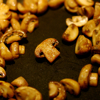
Coq au Vin
— adapted from the River Cottage Meat Book
1 stewing chicken, ideally a farmyard rooster*
1/4 cup butter
1T olive oil
8 ounces pancetta or bacon, cut into large chunks
8 ounces onions, cut into quarters
1/3 cup all-purpose flour, seasoned with salt and pepper
4 oz brandy
2 cups red wine
2 cups chicken stock
bouquet garni of parsley stalks, bay leaf, and thyme
4 celery stalks, cut into 1-1/2-inch lengths
4 garlic cloves, smashed
2 cups canned chopped tomatoes
—
6 to 8 carrots, cut into 1-1/2-inch pieces
1/2 pound white button mushrooms, halved or quartered depending on size
4 to 8 ounces small onions (such as cippolini or pearl), peeled and trimmed
Preheat the oven to 250°F. Cut the chicken into 4 serving pieces, reserving the neck, back, and wingtips (and feet and head, if available) for stock. Heat the butter and oil in a large ovenproof casserole. Fry the bacon pieces in the butter/oil until browned, and remove to a plate with a slotted spoon. Lightly brown the onions in the same pan, and likewise remove them to the plate.
In a paper bag, shake the chicken pieces with the seasoned flour until coated, tapping them against the side of the bag to remove any excess. Brown the dredged chicken in the bacon-butter-oil, working in batches if necessary so as not to crowd the pan, and turning to brown all sides properly. If you’ve worked in batches, return all the chicken parts to the casserole. Pour the brandy over the chicken and (very, very carefully) flame it with a long-handled match. When the flames die down, remove the chicken to the plate with the onions and bacon.
Add the red wine to the casserole, scraping the bottom and sides of the pan to remove any stuck-on bits. Add the stock to the pan and heat to a simmer. Then return the bacon, onions, and chicken to the pan along with the herbs, celery, garlic, and tomatoes. Bring to a gentle simmer. Cover and cook in the oven for 2 to 2-1/2 hours (more like 1-1/2 hours for a younger chicken) until the meat is completely tender.
When you’re within a half-hour of serving time, saute the mushrooms in a bit of olive oil. Please resist the temptation to salt them until they are browned and delicious — you will get a much firmer, tastier mushroom. Meanwhile, in a small frying pan, gently cook the carrots and onions in a shallow layer of water, turning them occasionally and removing them from the pan when they’re just cooked through.
When the chicken is ready, check the consistency of the sauce. If you have a very tight-fitting casserole lid, and/or a wimpy chicken, you may need to reduce the liquid by as much as half of its volume. (Leave the chicken and vegetables in the covered casserole, and reduce the sauce in a separate pan.) Once your pan sauce is thick enough to coat the back of a spoon, put everything together — chicken, vegetables, mushrooms, and sauce — and bring back just to a gentle simmer.
Adjust seasonings to taste, and serve with your favorite mashed potatoes or herbed new potatoes.
* If no roosters are available, HF-W recommends substituting the legs, wings, neck, and giblets of a good free-range turkey, leaving the breast to be roasted another day.
Dark Days challenge, locavore, recipes, shopping
26 Comments »




Posted by Anita on 02.06.08 11:10 PM
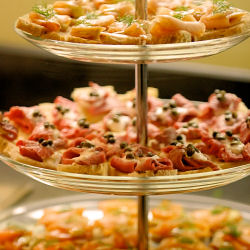 You’d be forgiven for thinking that locavore eating in the dead of winter means a limited palate of kale-green, potato-brown and cauliflower-beige. But, much to our very pleasant surprise, we’ve been cooking up a colorful assortment of oranges, pinks, purples… and even reds.
You’d be forgiven for thinking that locavore eating in the dead of winter means a limited palate of kale-green, potato-brown and cauliflower-beige. But, much to our very pleasant surprise, we’ve been cooking up a colorful assortment of oranges, pinks, purples… and even reds.
I’ve told you about two of the drinks at our cocktail soirée, but here’s a little secret about the nibbles we served: Everything was at least 90% local, and most of it came from entirely within our 100-mile radius.
The prettiest plate of the night was Cameron’s gorgeous tower of tiny Martha-inspired canapes: roast beef and horseradish on herb bread, and two different kinds of smoked salmon with mustard-fennel sauce on rye. An assorted platter of Fatted Calf pâtés and sausages took their place beside a trio of locally produced mustards. The crudite plate included too-cute-to-eat baby carrots, fractal-icious romanesco, and blushing breakfast radishes. A batch of pesto-filled pastry pinwheels, a spicy dip of Rancho Gordo black beans, and a platter of Northern California cheeses rounded out the savory stuff. On the sweet side, a batch of Earl Grey-scented tea cookies caused such a stir that three different guests asked for the (ridiculously easy) recipe.
Much as I adored the tea cookies, my favorite new party recipe isn’t a recipe at all. We cut a big bagful of Happy Quail piquillo peppers in half — yes, we had local peppers in January! — removed the seeds, and stuffed them with a mixture of Fatted Calf chorizo and Acme breadcrumbs. A few minutes under the broiler and we had the most popular hors d’oeuvre of the evening. I can hardly wait until next season to try it again!
After a party like that, that last thing we wanted to do was cook. As the month wound down, we hit up some of our favorite restaurants to see what their midwinter menus had in store. Nopa served us yet another scrumptious supper courtesy of our local farmers: we split an order of goat cheese fondue, followed by a grass-fed burger for Cameron and grass-fed shortribs for me. A few days later we ended up with friends at The Alembic, where we shared local lamb sliders and a sinful order of truffled mac-and-cheese made with Mt. Tam and Serena — two of our favorite Northern California cheeses.
With Dark Days like these, it’s hard to feel deprived.


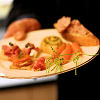
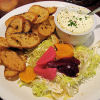

Dark Days Ticker — January 16-30
– Dark Days dinners at home: 7 (out of 16), plus the party food
– Locavore dining-out: Alembic, Nopa, Range
– New recipes: Pesto pinwheels, chorizo-stuffed peppers, Earl Grey tea cookies
– Old faves: Mom’s quiche Lorraine, Julia Child’s beef stew
– Freezer fodder: Linguine Bolognese, chicken & dumplings
New (to us) local items
– Cap’n Mike’s smoked salmon — red and white varieties
– Piper-Sonoma Brut and Blanc de Noirs sparkling wine
– Capellino pesto in a tub (made in SF!)
– Bellwether Farms’ pecorino-style Pepato
– La Clarine Farm’s Sierra Mountain goat Tomme
– Eatwell Farm‘s romanesco
– Happy Quail Farms piquillo peppers (last of the season!)
– Local mustards from Made in Napa Valley, Mendocino Mustard and Narsai’s
Dark Days challenge, entertaining, locavore
11 Comments »




Posted by Anita on 01.25.08 10:34 PM
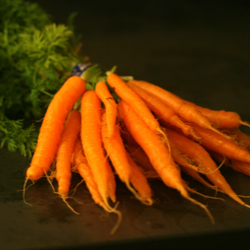 We haven’t gone in much for New Year’s resolutions this year, but we are making a few small changes. As part of our Dark Days Challenge (and as a side effect of finally finishing reading Omnivore’s Dilemma, two years behind the curve) we’re moving more of our food-budget dollars around. We’d already dabbled a bit in acclimating our palates to grass-fed beef, and we’re going to get more serious about it this coming year.
We haven’t gone in much for New Year’s resolutions this year, but we are making a few small changes. As part of our Dark Days Challenge (and as a side effect of finally finishing reading Omnivore’s Dilemma, two years behind the curve) we’re moving more of our food-budget dollars around. We’d already dabbled a bit in acclimating our palates to grass-fed beef, and we’re going to get more serious about it this coming year.
But possibly the largest change — one that has an effect on something we eat literally every day — is making the switch to pastured eggs. As I mentioned in the comments to our last Dark Days post, I finally decided that spending the extra cash for ethically raised eggs was really not going to put a huge dent in the food budget. But man, $7 a dozen feels extravagant when you’ve been spending $2.25 for quasi-organic eggs.
Which brings me to one of my first food discoveries of the new year: Just because you buy your eggs from a joke-cracking fella at the Ferry Plaza market doesn’t mean they’re ethically raised. (If you get your eggs from Judy’s Family Farm or any of the other eggs at the stand across from June Taylor, do yourself a favor and click that link.) Needless to say, I was pretty pissed off to discover that I’d been duped by what Michael Pollan might call “farmers market pastoral.” It took a dose of righteous anger to open my eyes: A $5-per-week premium isn’t outrageous. It’s a tiny fraction of our food budget, and a drop in the bucket compared to the cost buying of ethically farmed meat.
 With that little surprise under my belt, I reluctantly started digging deeper into the true origins of other items that I’d previously assumed were sustainably produced. Much to my pleasant surprise, Clover Organic and a number of other brands I suspected might be greenwashing were entirely on the level. (I’m not sure whether I was more shocked by my egg supplier’s betrayal or the honesty of one of the area’s largest dairies.)
With that little surprise under my belt, I reluctantly started digging deeper into the true origins of other items that I’d previously assumed were sustainably produced. Much to my pleasant surprise, Clover Organic and a number of other brands I suspected might be greenwashing were entirely on the level. (I’m not sure whether I was more shocked by my egg supplier’s betrayal or the honesty of one of the area’s largest dairies.)
But back to the sunny side: Putting together Dark Days meals continue to feel far too easy. Our summer of canning, salting, freezing, and otherwise preserving the harvest is paying off in spades; sometimes dinner’s as simple as opening the freezer, thawing a bag of protein, and heating up a starch and a farmers market vegetable to go alongside.
We’ve also managed to add a number of new local items to our roster of ingredients. In the first half of the month, we sourced Liberty duck from Sonoma County Poultry (Penngrove – 48 miles); Giusto’s flour and baking soda (South San Francisco – 8 miles), and of course those Eatwell Farm pastured eggs (Dixon – 67 miles).

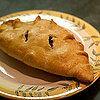

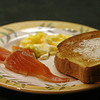

Dark Days Ticker — January 1-15
– Dark Days dinners: 7 (out of 15)
– New recipes: Duck burgers, country-fried steak, Cornish pasties
– Old faves: One-day cassoulet (leftovers)
– Freezer fodder: Chile verde tacos; gravlax; linguine Bolognese; fusilli marinara
Dark Days challenge, locavore, shopping
13 Comments »




Posted by Anita on 01.13.08 2:08 PM
 Suffice to say that we had such a relaxing time on our vacation that it’s taking us an inordinately long time to get back in the swing of things. We’ve been home nearly 2 weeks now, and I am finally getting my head out of the clouds long enough to tell you about all the gorgeous food we ate.
Suffice to say that we had such a relaxing time on our vacation that it’s taking us an inordinately long time to get back in the swing of things. We’ve been home nearly 2 weeks now, and I am finally getting my head out of the clouds long enough to tell you about all the gorgeous food we ate.
Our 10 days away — in a little cottage in the foothills above Napa Valley — were incredibly relaxing. We brought along two coolers full of food from the farmers market (our landlord eyed the back of our car and quipped, “You know, we do have grocery stores here…”) and we spent nearly every day sitting by the fire, catching up on our reading, and cooking amazing food.
The day we drove up, we bought a pair of enormous Dungeness crabs from Shogun fish on their last market day of the season. The first night in our little cottage, Cameron picked the crabs and we sauteed the meat in Spring Hill Farm butter along with some zest from our backyard lemons and a few slices of green onions. Served over Eduardo’s linguine, with a salad and a split of Schramsberg sparkling wine, it was the perfect settling-in meal.
Of course, there was plenty of leftover crab meat! The next day, we turned part of it into crab omelettes for brunch, then mixed the rest into a sumptuous batch of fondue mac-and-cheese. Monday night, we whipped up a 100% local batch of Jen’s chicken cacciatore with an heirloom chicken from Prather and some Far West Funghi chanterelles, served over Full Belly Farm polenta with a bottle of Calistoga Cellars Zinfandel.
Tuesday night was Christmas supper: Mini beef Wellingtons! Prather Ranch filet mignon wrapped in puff pastry with a slice of Fatted Calf foie gras and duxelles made from Far West cremini mushrooms, Spring Hill butter, and Straus cream. On the plate: A sauce of red-wine-infused demiglace (homemade from Prather bones) and a side of Iacopi green beans quick-braised with Fatted Calf pancetta. We drank a bottle of Cabernet from Mount Veeder Winery, just a few miles down the road from our cottage.
Wednesday night, we turned to our usual lazy-day standby: Pasta Bolognese with a big green salad. Thursday we took the night off from kitchen duty, and headed down the hill for a gorgeous sushi-fest at Go Fish. By Friday, we were ready to cook again: We pulled the last of our homemade spiral sausage out of the freezer and served it along with cauliflower soup made from farmers market veggies and a mixture of orphan pieces from the local cheese plate we’d been nibbling all week.
Saturday night Cameron made an improvised braise of Prather beef cheeks, with homemade beef stock, home-canned tomatoes, and herbs from the garden. Served with more Full Belly polenta and some Ella Bella broccoli rabe, it was the perfect supper for the chilliest night of our trip.
Sunday night, we began prepping our traditional New Year’s cassoulet. While the stovetop was occupied simmering Rancho Gordo beans, searing Toulouse sausages, and cooking off Fatted Calf duck confit, we used the oven to roast a most gorgeous Range Brothers pork rib roast. An unorthodox recipe for potato gratin — started on the stovetop and finished in the oven while the roast rested — turned out beautifully… a perfect showcase for Little’s potatoes, Bellwether Farms cheese, and Clover dairy. We usually roast our Brussels sprouts, but because our baby oven couldn’t accommodate a roast and a side dish, we tried a new-to-us method: Sauteeing the shredded sprouts in rendered pancetta fat, and adding the crisped pork back to the finished dish at the end. (We loved it so much, we’re having it again tonight.)
Monday night — New Year’s eve — meant it was finally time to break into the cassoulet that had been tempting us with its luscious smells for the last 24 hours. A rough-but-tasty bottle of Pinot Noir and a big salad were all we needed to round out its delicious pork-infused goodness.
Packing the next morning was almost impossibly hard; our little kitchen had served us so well for our 10 days away! Unlike most rental houses, this one was well stocked with high-end cookware and thoughtful staples (organic eggs and Bouchon pastries awaited us our first morning). But the ultimate luxury was having the time to putter in the kitchen all day, every day. The space was cozy, and the equipment a bit spare, but it was such a treat to forget about the office, the phone, and all of our usual distractions for a few days and cook together.
We planned all along to keep up with the Dark Days challenge while we were gone, but looking back over our photos, we were surprised at just how well we’d done. With the exception of cocktails, a few lunches out, and our one in-town dinner, everything we ate and drank during our trip came from local sources. Getting to the 90% local, five-nights-a-week mark has become pretty achievable for us on a regular basis. It’s comforting to know we could get to 100% local — given unlimited time to plan, to shop, to cook — even if it’s not something we’re able to do in the workaday world.

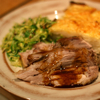

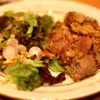

Now, in theory, the Dark Days challenge wrapped up at the end of last year, with an optional extension into 2008. We’re having such a ball, we’ve decided to continue with the challenge, along with more than 20 other participants. Because our hostess, Laura, is in the midst of moving her house (and her chickens!), official wrap-ups will taper off to every two weeks.
Because it’s a new year, we’re going to make some changes to our own ground rules, too. Here’s our revised game-plan:
- We will continue to cook locally as often as we can, with a baseline of two dinners per week made from 90% local ingredients.
- We will write about
at least two meals a week made with as many local ingredients as we can source. our locavore adventures regularly, but we’re going to dispense with the litany of meals and sources, as it’s getting rather repetitious and a bit boring for non-locavore readers. We WILL talk about new pantry items, new farmers we’ve discovered, and recipes for in-season items within our foodshed.
- Local for us will be a 100-mile radius for produce and a 200-mile radius for protein. We will try to keep our protein within a 50- to 100-mile radius at least twice a week. Strong preference will be given to items purchased directly from farmers at market rather than retail. Our protein will include pastured eggs, poultry, and pork, as well as grass-fed beef. When grass-fed is not available or not appropriate, we will use 100% humanely raised, pastured beef. (I find grass-fed beef too gamey in grilled or stir-fried preparations, but for braises and stews, it’s our new default.)
- We’re making the usual ‘Marco Polo’ exemptions for seasonings.
We’re also making exceptions for flour, dried pasta, white rice, and polenta — we have no local sources of these ingredients, and man does not live by potatoes and bread alone. We will try to source baking ingredients locally, but I don’t expect to find much beyond nuts, and I won’t go through the holidays without baking. (We’ve found local sources for all of our grains.)
- We’ll try to limit processed and prepared foods to those produced within a 50-mile radius. We’ll try to determine how much local ingredient sourcing they’re doing, and talk about it in our posts.
- We’ll continue with the challenge through the end of
the year, and then re-evaluate on New Year’s Day along with other participants. March.
Dark Days challenge, locavore, Napa & Sonoma, travel
6 Comments »




 I think it’s safe to say that by any objective measure, Dark Days are well behind us here in San Francisco. Asparagus has been on the farm tables for a month, strawberries made their Ferry Plaza debut this Saturday, and — hooray! — the first pasture-raised chicken of 2008 made its way into our bag (and our bellies) yesterday.
I think it’s safe to say that by any objective measure, Dark Days are well behind us here in San Francisco. Asparagus has been on the farm tables for a month, strawberries made their Ferry Plaza debut this Saturday, and — hooray! — the first pasture-raised chicken of 2008 made its way into our bag (and our bellies) yesterday. And for that, I owe huge debt to Laura — for dreaming up Dark Days, for hosting the weekly roundups last fall, and for extending the challenge into 2008 when we all clamored for more. I can only imagine how she manages her own blog and handles her roundups of every Dark Days blogger in the country, all while moving onto her new farm, raising a new brood of chicks, and working a full-time job. (Honestly, I’m exhausted just thinking about it…) I know in my heart that we’d never have dug as deep into our food chain if it hadn’t been for the thrill of the challenge, and knowing we had a built-in audience of Dark Days participants who would share our excitement.
And for that, I owe huge debt to Laura — for dreaming up Dark Days, for hosting the weekly roundups last fall, and for extending the challenge into 2008 when we all clamored for more. I can only imagine how she manages her own blog and handles her roundups of every Dark Days blogger in the country, all while moving onto her new farm, raising a new brood of chicks, and working a full-time job. (Honestly, I’m exhausted just thinking about it…) I know in my heart that we’d never have dug as deep into our food chain if it hadn’t been for the thrill of the challenge, and knowing we had a built-in audience of Dark Days participants who would share our excitement.





























































